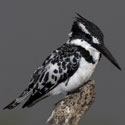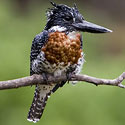|
Family: Cerylidae (cerylid kingfishers)
Life
> Eukaryotes >
Opisthokonta
> Metazoa (animals) >
Bilateria >
Deuterostomia > Chordata >
Craniata > Vertebrata (vertebrates) > Gnathostomata (jawed
vertebrates) > Teleostomi (teleost fish) > Osteichthyes (bony fish) > Class:
Sarcopterygii (lobe-finned
fish) > Stegocephalia (terrestrial
vertebrates) > Tetrapoda
(four-legged vertebrates) > Reptiliomorpha > Amniota >
Reptilia (reptiles) >
Romeriida > Diapsida > Archosauromorpha > Archosauria >
Dinosauria
(dinosaurs) > Saurischia > Theropoda (bipedal predatory dinosaurs) >
Coelurosauria > Maniraptora > Aves
(birds) > Order: Coraciiformes
|
Ceryle
rudis (Pied kingfisher) The Pied kingfisher
is one of three most common kingfishers in the world, being found in many
areas of Africa and Eurasia, living in a wide range of aquatic habitats. It
feeds mainly on fish, spotting prey by either sitting on perches or
hovering, which it does more than any other kingfisher. It is a cooperative
breeder, meaning that the breeding pair are assisted by helpers, who can
either be offspring, or unrelated birds, who's breeding attempts failed. The
chicks stay in the nest for 24-29 days, after which they are still dependent
on their parents for 1-2 months. |
 |
|
Ceryle maxima (Giant
kingfisher) The Giant kingfisher is fairly common in
southern Africa, and is found mainly in South Africa and Zimbabwe, living in
many types of aquatic habitats. It feeds mainly on crabs, with fish largely
making up the rest of its diet. Both sexes excavate the nest, which takes
about 7 days, and is dug into vertical sandbanks. Amazingly, they can
excavate tunnels as long as 8.45m!. It lays 3-5 eggs, which are incubated by
both sexes, for 25-27 days. The nestlings are fed mainly by the male, once
every 48-213 minutes. They seem to stay in the nest for about 37 days, after
which they are still dependent on their parents for at least 21 days |
 |
|
